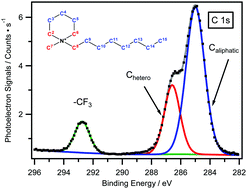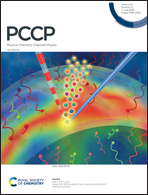X-ray photoelectron spectroscopy of piperidinium ionic liquids: a comparison to the charge delocalised pyridinium analogues†
Abstract
In this study, nine piperidinium-based ionic liquids are analysed by X-ray photoelectron spectroscopy. The effect of alkyl substituent length and the nature of the anion on the electronic environment of the cation are investigated. The electronic environment of the hetero carbon and the cationic nitrogen is compared between two structurally similar cations, 1-octyl-1-methylpiperidinium ([C8C1Pip]+) versus 1-octylpyridinium ([C8Py]+). Due to the charge delocalisation, the hetero carbon component within [C8Py]+ is more positively charged, which exhibits much higher binding energy; whilst the cationic nitrogen component is in the similar electronic environment. The impact of the charge delocalisation on the electronic environment of the anion is also compared between [C8C1Pip]+ and [C8Py]+. It is found that for the more basic anion, the cation can significantly affect the electronic environment of the anion; for the less basic anion, such an effect concentrates on the component bearing more negative point charges.



 Please wait while we load your content...
Please wait while we load your content...